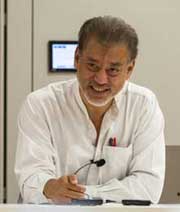ARTICLE AD
KUALA LUMPUR, Malaysia, Mar 13 (IPS) - Much higher interest rates – due to Western central banks – are suffocating developing nations, especially the poorest, causing prolonged debt distress and economic stagnation.
US Fed-induced stagnation After the greatest US Fed-led surge in international interest rates in more than four decades, developing countries spent $443.5 billion to service their external government and government-guaranteed debt in 2022.
 Jomo Kwame SundaramThe World Bank’s last International Debt Report showed most of the poorest countries in debt distress as borrowing costs began to surge. The increase has cut into scarce fiscal resources, reducing social spending on health and education.
Jomo Kwame SundaramThe World Bank’s last International Debt Report showed most of the poorest countries in debt distress as borrowing costs began to surge. The increase has cut into scarce fiscal resources, reducing social spending on health and education.Debt-servicing costs for all developing countries in 2022 increased by 5% over 2021. The US Fed continued to raise interest rates through 2023, compounding debt distress, while the European Central Bank warns against ‘prematurely’ lowering interest rates.
Poorest worst off The 75 countries eligible to borrow from the World Bank’s International Development Association (IDA) – which only lends to the world’s poorest – paid $88.9 billion to service debt in 2022.
Over the last decade, the cumulative debt of IDA-eligible countries grew faster than their economies. Their foreign debt stock reached $1.1 trillion in 2022 – more than twice that in 2012. During 2012-22, their external debt rose 134%, over twice the 53% increase in national income.
Interest payments by the poorest countries have quadrupled over the previous decade to $23.6 billion in 2022. The Bank expects debt-servicing by the 24 poorest countries to jump by as much as 39% in 2023 and 2024.
Growing debt distress Bank Chief Economist cum Senior Vice President Indermit Gill has warned, “Record debt levels and high-interest rates have set many countries on a path to crisis”. “Every quarter that interest rates stay high results in more developing countries becoming distressed...”
Without “quick and coordinated action by debtor governments, private and official creditors, and multilateral financial institutions” and “better debt sustainability … and swifter restructuring” arrangements, “another lost decade’’ seems unavoidable! Higher interest rates have worsened debt distress in most developing countries. There have been 18 government debt defaults in ten developing countries in the last three years – more than in the previous two decades!
Poorest hardest hit About three-fifths of low-income countries (LICs) are in or at high risk of debt distress. Debt service payments consume an increasingly large share of their export earnings. Over a third of their external debt has variable interest rates, which have risen sharply over the last two years.
The Bank acknowledges, “Many of these countries face an additional burden: the accumulated principal, interest, and fees they incurred for the privilege of debt-service suspension under the G-20’s Debt Service Suspension Initiative (DSSI).”
With higher Fed rates, the stronger US dollar worsens developing countries’ difficulties, raising debt-servicing costs. Besides high interest rates, falling export earnings – due to lower demand – are worsening things.
Where have all the lenders gone? New financing for the global South has dried up with the flight of capital ‘uphill’ to the North. New borrowing has been made harder by interest rate and debt-servicing cost increases.
New government and government-guaranteed foreign loan commitments to these countries fell by 23% to $371 billion in 2022 – the lowest in a decade.
Private creditors have been avoiding developing countries and got $185 billion more in principal repayments than they loaned in 2022. It was the first year they received more than they loaned to developing countries since 2015.
New bonds issued by developing countries internationally dropped by over half in 2022! New bond issues by IDA-eligible LICs and other countries fell by more than three-quarters to $3.1 billion.
With much less private financing, multilateral development banks, especially the World Bank, loaned much more. Multilateral creditors provided $115 billion in new concessional financing to developing countries in 2022, with half from the Bank.
The Bank provided $16.9 billion more in such financing than it got in principal repayments – nearly thrice the amount a decade before. The Bank also disbursed $6.1 billion in grants to these countries, three times the amount in 2012.
Wrong medicine As the US Fed continued to hike interest rates through 2023 while the European Central Bank still warns against ‘prematurely’ reversing the rate hikes, the prospects of early relief appear remote, threatening further devastation in the global South.
The excuse for higher interest rates remains inflation above the completely arbitrary two per cent inflation targeting rate now embraced by all too many central bankers as their ‘holy grail’.
But most recent inflation has been due to often deliberate supply-side disruptions in recent years associated with the US-led new Cold War, COVID-19 pandemic disruptions and geopolitically driven economic sanctions, especially since the Russian invasion of Ukraine.
Core inflation has largely receded in much of the world since mid-2022. But meanwhile, imported inflation has been exacerbated by exchange rate depreciation due to financial flow-induced refluxes¬.
No solution on the horizon The 1980s’ government debt crises caused a ‘lost decade’ in Latin America and a quarter century of stagnation in Sub-Saharan Africa. It took almost a decade for the George H W Bush administration to resolve the Latin American debt crises with compromises around the Brady bonds.
This time, a resolution will be much more difficult owing to the varied creditors and much larger debt involved. Worse, there is little sense of responsibility in the West. Instead of seeking collective solutions, the evolving debt crisis is used to blame and isolate China in the fast-worsening geopolitical new Cold War.
IPS UN Bureau
Follow @IPSNewsUNBureau
Follow IPS News UN Bureau on Instagram
© Inter Press Service (2024) — All Rights ReservedOriginal source: Inter Press Service

 9 months ago
57
9 months ago
57 
